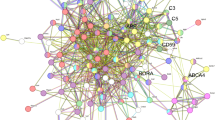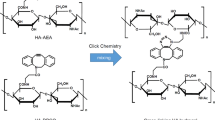Abstract
Background
Posterior capsular opacification (PCO) is the most common postoperative complication after cataract surgery, occurring in > 25% of adults. To combat this disease, new and more targets and drugs are still urgently needed. Plantamajoside (PMS) is a natural compound extracted from planajoside and has a wide range of biological activities. However, the role and effects of PMS in PCO are still unclear.
Objectives
To uncover the possible effects of plantamajoside (PMS) on posterior capsular opacification (PCO) progression and clarify the mechanism.
Results
PMS inhibited the proliferation of hLECs. PMS inhibited the autophagy of hLECs. Furthermore, PMS suppressed the motility and EMT of hLECs induced by TGFβ2. PMS suppressed the TGFβ2-induced inflammation of hLECs. Mechanically, PMS restrained the AGEs–RAGE axis, therefore, inhibiting PCO progression.
Conclusion
PMS could serve as a promising drug for PCO treatment.





Similar content being viewed by others
Data availability
All data generated or analyzed during this study are included in this published article. The datasets used and/or analyzed during the present study are available from the corresponding author on reasonable request.
References
AbouZid SF et al (2014) Antihyperglycemic effect of crude extracts of some Egyptian plants and algae. J Med Food 17:400–406
Alonistiotis D et al (2022) The influence of mild posterior capsular opacification on spectral domain optical coherence tomography retinal nerve fiber layer thickness. Int Ophthalmol 42:1811–1817
Bae SJ, Lee SH, Yun SJ, Kim K (2021) Usefulness of the blood urea nitrogen-to-serum albumin ratio as a prognostic indicator of severity in acute ischemic stroke. Signa Vitae 17:163–170
Camilloni A et al (2021) Chronic non-cancer pain in primary care: an Italian cross-sectional study. Signa Vitae 7:54–62
Han AR, Nam MH, Lee KW (2016) Plantamajoside inhibits UVB and advanced glycation end products-induced MMP-1 expression by suppressing the MAPK and NF-kappaB pathways in HaCaT cells. Photochem Photobiol 92:708–719
Han Y et al (2019) Anti-adhesive and antiproliferative synergistic surface modification of intraocular lens for reduced posterior capsular opacification. Int J Nanomedicine 14:9047–9061
Joao MD et al (2022) Intraocular lens position and anterior chamber parameters evaluation after Nd:YAG laser posterior capsulotomy for posterior capsular opacification using anterior segment swept-source optical coherence tomography. Clin Ophthalmol 16:153–159
Kitaguchi-Iwakiri Y et al (2022) Long-term incidence of posterior capsular opacification in patients with non-infectious uveitis. Sci Rep 12:4296
Li X et al (2018) Plantamajoside inhibits lipopolysaccharide-induced epithelial-mesenchymal transition through suppressing the NF-kappaB/IL-6 signaling in esophageal squamous cell carcinoma cells. Biomed Pharmacother 102:1045–1051
Lim JM, Kim JA, Lee JH, Joo CK (2001) Downregulated expression of integrin alpha6 by transforming growth factor-beta(1) on lens epithelial cells in vitro. Biochem Biophys Res Commun 284:33–41
Liu F et al (2019) Plantamajoside attenuates inflammatory response in LPS-stimulated human gingival fibroblasts by inhibiting PI3K/AKT signaling pathway. Microb Pathog 127:208–211
Luan Y et al (2021) Centrosomal-associated proteins: potential therapeutic targets for solid tumors. Biomed Pharmacother Biomed Pharmacother 144:112292
Ma B et al (2019) Gremlin is a potential target for posterior capsular opacification. Cell Cycle 18:1714–1726
Martellet MC et al (2022) Probiotic applications associated with psyllium fiber as prebiotics geared to a healthy intestinal microbiota: a review. Nutrition 103–104:111772
Martin-Carro B et al (2023) Role of klotho and AGE/RAGE-Wnt/beta-catenin signalling pathway on the development of cardiac and renal fibrosis in diabetes. Int J Mol Sci 24:5241
O’Brien CE, Bonanno L, Zhang H, Wyss-Coray T (2015) Beclin 1 regulates neuronal transforming growth factor-beta signaling by mediating recycling of the type I receptor ALK5. Mol Neurodegener 10:69
Prasad K (2021) AGE-RAGE stress and coronary artery disease. Int J Angiol 30:4–14
Shang L et al (2019) Plantamajoside attenuates isoproterenol-induced cardiac hypertrophy associated with the HDAC2 and AKT/ GSK-3beta signaling pathway. Chem Biol Interact 307:21–28
Shree B, Tripathi S, Sharma V (2021) Transforming growth factor-beta-regulated LncRNA-MUF promotes invasion by modulating the miR-34a Snail1 axis in glioblastoma multiforme. Front Oncol 11:788755
Son WR et al (2017) Plantamajoside from Plantago asiatica modulates human umbilical vein endothelial cell dysfunction by glyceraldehyde-induced AGEs via MAPK/NF-kappaB. BMC Complement Altern Med 17:66
Srivastava A et al (2021) Interleukin-6 induced proliferation is attenuated by transforming growth factor-beta-induced signaling in human hepatocellular carcinoma cells. Front Oncol 11:811941
Tomino Y, Hagiwara S, Gohda T (2011) AGE-RAGE interaction and oxidative stress in obesity-related renal dysfunction. Kidney Int 80:133–135
Wang Y, Yan D (2019) Plantamajoside exerts antifibrosis effects in the liver by inhibiting hepatic stellate cell activation. Exp Ther Med 18:2421–2428
Wang R et al (2021) Surface modification of intraocular lens with hydrophilic poly (sulfobetaine methacrylate) brush for posterior capsular opacification prevention. J Ocul Pharmacol Ther 37:172–180
Xie LK et al (2022) Capsella bursa-pastoris (L.) medic. extract alleviate cataract development by regulating the mitochondrial apoptotic pathway of the lens epithelial cells. J Ethnopharmacol 284:114783
Yin W et al (2020) Plantamajoside inhibits the proliferation and epithelial-to-mesenchymal transition in hepatocellular carcinoma cells via modulating hypoxia-inducible factor-1alpha-dependent gene expression. Cell Biol Int 44:1616–1627
Zhuang H et al (2021) Fluorofenidone inhibits epithelial-mesenchymal transition in human lens epithelial cell line FHL 124: a promising therapeutic strategy against posterior capsular opacification. Arq Bras Oftalmol 84:258–266
Zukin LM et al (2018) Aldose reductase inhibition prevents development of posterior capsular opacification in an in vivo model of cataract surgery. Invest Ophthalmol vis Sci 59:3591–3598
Zuo X, Li L, Sun L (2021) Plantamajoside inhibits hypoxia-induced migration and invasion of human cervical cancer cells through the NF-kappaB and PI3K/akt pathways. J Recept Signal Transduct Res 41:339–348
Acknowledgements
Not applicable.
Funding
This work was supported by the Scientific Research Project Weifang City Health Committee. (Grant No. WFWSJK-2021-002).
Author information
Authors and Affiliations
Contributions
Xiaoxiang Sun designed the study, completed the experiment and supervised the data collection, Xuequan Sun analyzed the data, interpreted the data, Xinyan Xu, Yuxuan Wang and Susu Lu prepare the manuscript for publication and reviewed the draft of the manuscript. All authors have read and approved the manuscript.
Corresponding author
Ethics declarations
Conflict of interest
Author Xiaoxiang Sun declares that he/she has no conflict of interest; author Xuequan Sun declares that he/she has no conflict of interest; author Xinyan Xu declares that he/she has no conflict of interest; author Yuxuan Wang declares that he/she has no conflict of interest; author Susu Lu declares that he/she has no conflict of interest.
Ethical approval
Not applicable.
Additional information
Publisher’s Note
Springer Nature remains neutral with regard to jurisdictional claims in published maps and institutional affiliations.
Rights and permissions
Springer Nature or its licensor (e.g. a society or other partner) holds exclusive rights to this article under a publishing agreement with the author(s) or other rightsholder(s); author self-archiving of the accepted manuscript version of this article is solely governed by the terms of such publishing agreement and applicable law.
About this article
Cite this article
Sun, X., Sun, X., Xu, X. et al. Plantamajoside ameliorates TGFβ2-induced autophagy, epithelial–mesenchymal transition and inflammatory processes in human lens epithelial cells. Mol. Cell. Toxicol. (2024). https://doi.org/10.1007/s13273-024-00456-4
Accepted:
Published:
DOI: https://doi.org/10.1007/s13273-024-00456-4




